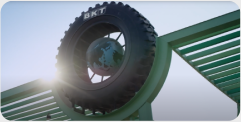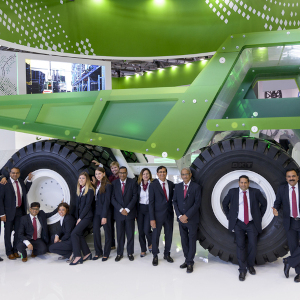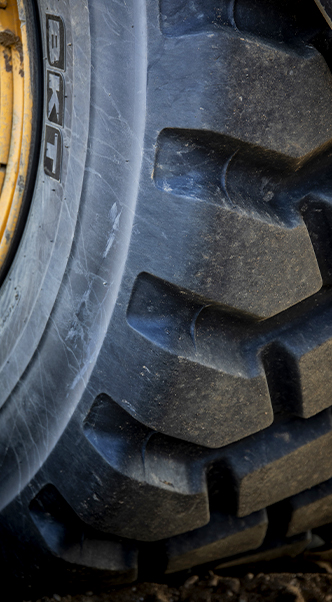In der Landwirtschaft und im Baugewerbe gehören Verschleiß und Abnutzung zum Alltag - was aber nicht bedeutet, dass wir nicht etwas dagegen tun können. Im Folgenden stellen wir Ihnen einige Tipps vor, mit denen Sie dem Reifenverschleiß entgegenwirken können.
In these turbulent times we live in, with the steady rise of the cost of living, and ever-growing challenges within the entire supply chain, it has become increasingly essential that we save costs and work more efficiently where we can. This is a necessity, in order to meet the day-to-day demands of both the agricultural and construction industries: two industries where tires are paramount.
The last thing we need when sowing or ploughing a field, or likewise, navigating the construction site, is a blown tire or one that is hindering performance. Both agricultural and industrial tires are specifically built to last, but without proper care and maintenance, their lifespan can be significantly reduced.
Wear and tear comes with the territory - but this doesn’t mean we cannot take steps to prevent it. Below, we will guide you through a few tips that you can adopt to combat tire wear and tear.
What Causes Tire Wear and Tear?
There are a plethora of reasons why your tires can become gradually - or rapidly - worn down. “Wear and tear” simply refers to the inevitable damage caused through repeated use over time, and unavoidable factors that accompany a tire’s workday - such as terrain and weather conditions - can contribute to this. However, tires should be fit to purpose, and there are further measures that can be taken to ensure that your tire lives its fullest life, while carrying out the daily grind.
The most common types of tire wear and tear manifest as cuts, punctures, impacts, cracks, bulges and irregular wear (which can include heel and toe wear, centre wear, and one-sided wear). In addition to outside variables, the function of the tire itself can cause premature damage, from high and low pressure, to incorrect wheel position. So, what steps can we take to combat this?
Fit For Purpose
First things first, ensure that the tire is specially designed for your application and the job at hand. As previously mentioned, you need to ensure that your tire is fit for purpose; having the right tire will increase efficiency, reduce damage, and meet health and safety requirements, allowing the tires to work at full capacity. In an attempt to save time, this stage can often be overlooked, which could cost more time - and money! - in the long run if things go wrong. Preventing hurdles before they arise is always a good mentality to have - trust us!
For example, tractor tires are designed for soil, as opposed to the road. Therefore, although this is sometimes unavoidable, it is best to reduce the frequency of driving on the road as much as possible, as asphalt is very abrasive. If you do find yourself needing to take a road route, ensure you drive slowly to reduce slippage. Road vehicles can quite easily overtake so do not feel pressure to increase speed. Small self reminders such as this can make the world of difference!
Did Somebody Say Inflation?
This may seem like it goes without saying - but we will say it anyway! You must make sure your tire is properly inflated. Put simply, keeping the proper inflation pressure will increase the tire’s life.
Inflation depends on axle load, and the job at hand. So, you will need to find out the maximum weight per axle, according to the manufacturer - making sure you include any weight that will be attached to the vehicle. Incorrect pressures can affect performance, wear, and soil compaction, which naturally results in a costly impact. Under and over inflation are both equally risky: under inflated tires will be unbalanced, with potential sidewall damage, whilst over inflated tires cause greater soil compaction and overall wear and tear.
It is also worth noting that the upcoming months approaching winter may cause tire pressure to drop, in comparison to summer. But all will be well, so long as you are weather aware and check tire pressures regularly, as they may need to be adapted for different jobs and different weather conditions.
Consider your Tread Pattern
Consider the tread pattern of your tire before you purchase. The tread pattern can make a distinct difference in how quickly you wear out tires, not to mention the overall performance of the machine. Tread is the pattern which goes along the circumference of the tire, and is the first point of contact with the ground.
For more information about the different types of tread, check out this guide.
Safe and Sound Storage
You’d be surprised at how many tires are stored incorrectly, and the detrimental effect this has on their lifespan. So, how do you store tires properly when you aren’t using them?
Firstly, you should always clean them before storing, ridding your tires of dust, grime and dirt, which can, in fact, damage them if it builds up in the long run. Simply utilize a tire brush, soap and water, and then air dry. Next, you should place your tires in an airtight bag when dry, preventing the lubricating oil from evaporating when in storage. Make sure that your tires are stored upright in a cool dry place. If you need to stack, do so in a way that reduces the likelihood of them toppling over. Remember how we were all told not to wear black in the summer? Similarly, black tires absorb heat, so if they are left out in the sun, this can cause an increased breakdown over a shorter period of time.
Put simply, preserving your tires through correct storage massively cuts costs, by reducing the need to replace as frequently. One more storage tip: rotate tires, as recommended by the manufacturer, to maintain even tire wear over time.
Reduce Speed and Braking
Reduce speed and braking, especially on rough terrain, to reduce wear and tear. Spot signs of wear: unevenness across the tread could be caused by road travel, so ensure you remove weights from the vehicle when not needed, and examine all splits, sidewalls, and potential puncture material before setting off.
Why Choose BKT Tires?
Ensuring good maintenance habits can prolong the life of tires, subsequently reducing costs, improving efficiency and being overall better for the environment.
BKT Tires are renowned as the go to option for all industrial purposes: including agricultural, construction and mining equipment, and more! Our tires are built to last, and we offer a variety of products designed to fit each of your automotive needs. Check out our range here, for the very best starting point to a wear and tear-free tire life!






